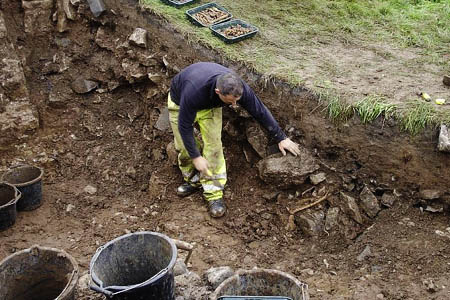The discovery of a body close to a controversial quarry has caused a stir in the Peak District.
But police won’t be looking into the find – the skeleton is thought to be about 2,000 years old. The discovery was made during the excavation of an Iron Age hillfort near Fin Cop, about 5km (3 miles) south-west of Backdale Quarry on Longstone Edge.
The adult skeleton, which had been thrown into a ditch and covered with stones, was uncovered during a three-week dig at the site. Longstone Local History Group was involved with the project, run by commercial outfit Archaeological Research Services at the site, overlooking Mosdal Dale.
The excavations, which are on private farmland with no public access, have now been re-covered. The site is close to the popular Pennyunk Lane footpath.
Members of the local history group shifted more than 2m of soil and rubble covering the area, to help solve the mystery of how the fort and ditch had been constructed. 78 volunteers were helped by 160 children from Longstone CofE Primary School, who also unearthed mesolithic artefacts which could be more than 12,000 years old.
Ann Hall, project manager for the Longstone Local History Group, said: “We all feel very privileged to have been given permission to investigate below the surface of this scheduled ancient monument; even for just a short time.
“The site is on private land with no public access and now we have restored the land, there is nothing left on site to show all the amazing features which have been discovered. The skeleton has been carefully removed along with all the finds. These will be analysed by specialists to give us much more information about what happened in the past.”
Sarah Whiteley, senior conservation archaeologist with the Peak District National Park Authority, which provided support and advice, said: “We’ve been really pleased to work with the Longstone Local History Group, Archaeological Research Services and the landowner.
“The project has given so many people a unique experience, helping them develop their understanding of the locality and their archaeological skills. The excavations cast new light on our understanding of the site, it’s been a tremendous achievement and we’d like to thank everyone involved.”
The dig was made possible by a £49,000 grant from the Heritage Lottery Fund.
English Heritage inspector of ancient monuments for Derbyshire, Jon Humble, said: “This project shows, quite literally in spades, what can be achieved when professional archaeologists, community and school groups work together on an archaeological mystery – and there are many more mysteries out there in the Peak District that have yet to be solved.”
It is believed the Iron Age hillfort is between 3,000 and 2,000 years old. Radiocarbon dating of surviving material is likely to enable more accurate dating. Tools and weapons made from stone from the Lake District and the Yorkshire Wolds or Lincolnshire were also found. The corpse will be analysed to try to determine its sex, age and origin.
The results will be announced at a Derbyshire Archaelogical Day in Chesterfield in January next year.

michaelkemsons
16 June 2012well gerry sorry iv took so long here is the link
filling address , there there most competitive in the game ,tell them micky heemson said you would sort him out